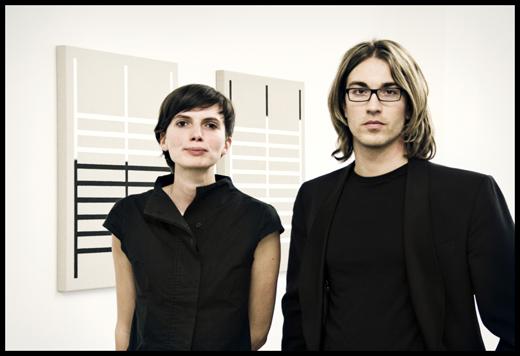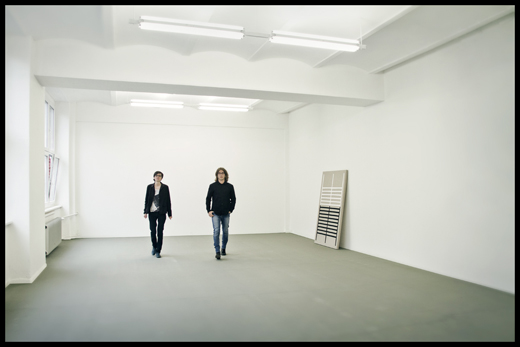Have you met... Rolando Anselmi from Delloro
Have you met... Rolando Anselmi from Delloro

Last February, Delloro opened its doors again after relocating in Kreuzberg with a concert by Martin Creed and his band that you probably attended or at least heard about.
The Berlin-based gallery is the second project of Rolando Anselmi, an Italian architect who after pursuing an academic career at the Institute of Technology in Berlin, changed his plans to work out his own ideas. He then opened Delloro in Rome, together with Carlo Pratis. A few years later, he decided it was time to move on and spread, and this is how he came back to Berlin in 2011 to open a second gallery in Mitte, before moving, and this time for good, to the core of Kreuzberg.
Our guest diary SNAP! photographer, Laura Gianetti, accompanied me this time and took portraits of Rolando with his assistant, Stefania Facco.
What was your initial idea? When did you get started?
We opened Galleria Delloro in Rome in 2007. Three years later, I decided to move back to Berlin. Opening a second space here responded to a natural process, at some point I had established a certain relationship with the city. We were then first located in Mitte for about six months. The spot was quite central, in the Museum Island, but we didn't like it there as much as we do here in Kreuzberg.
What is your curatorial angle?
I think the curator is more of a specific figure, and I don't think of myself as such. I am essentially a gallerist, someone who has to take care of plenty of issues related to production, apart from doing the research and choosing the artists, of course. I always try to work with a curator who is in the same wavelength as me. For instance, once we worked together with some curators from the Macro Museum in Rome for a project in public space. Environmental projects and exhibitions in public space is also one of our main interests.
How did you develop over the time?
At the very beginning, we had a more historical approach: we were focused in the avant-garde. Luckily, I got to work with some old masters from this period in my early days. I learned a lot from them. Not only about Art History, but also about the ethics of this world, something that is sometimes missing in the new generations. Young artists are now more focus on themselves. What is really interesting about these movements from the seventies is the fact that it was about the collective rather than the individual. Artists were living and working together, delivering a common message, an idea, instead of establishing their own names.
It's been years since that, and it is natural that at the end we also got more attracted to contemporary art. We are attending now to what will be established in the next ten years. And ,as a gallerist, you also want to write a little piece of history.
How do you finance yourself?
Selling works. That's the whole point. We are here to make exhibitions, but if we can't sell what we are showing, the whole thing would completely fail. Since we started in 2007, we have attended to how the economical crisis has directly affected the art market. We learned from fellow gallerists, that until 2005-2006 things were going swimmingly, they were selling good. But now everybody seems to be experiencing how challenging is to sell contemporary art these days.
What are the main differences between the space in Rome and this one in Berlin?
The project here in Berlin is something completely different to all what we did before. In Rome we started showing artists from the seventies avant-garde. Now we are more opened to the contemporary and to young artists. Davide Balliano is the youngest artist we have exhibited so far.
We also have the opportunity to foster artists in this space, as a sort of residency program. They can live and work here, producing site specific works for the gallery during their stay.
There is also a remarkable difference between the two cities in what comes to their markets: while in Rome we don't have many big collectors, the art market is way more dynamic there. There is a strong leading middle class who is keen to buy art, even in a moderate budget. You can find plenty of collectors who are dealers at the same time. They are giving the art market a boost. Although it seems like there are bigger budgets here, collectors usually move in small circles around the same gallery names in Berlin.
Isn't it symptomatic, due to the nature of Berlin, that you opened such a space here instead of a more regular commercial gallery like the one in Rome?
Well, this is also a regular gallery, with regular opening times and selling goals, but the good thing is that we also got more room here and therefore more possibilities to realize projects like providing accomodation for the exhibiting artist.

A gallery like this is inconceivable in Rome. First, it is not easy to find a space like this in the city center due to the historical nature of it's architecture. And second, it would be absolutely unaffordable. Delloro Rome is housed in a medieval building, so we have to be very respectful with the cultural heritage. We can't drill, paint or remove anything. But here we are free to transform the space the way we like.
What are your favourite venues for art in Berlin?
Classic Berlin institutions such as Kunstwerke or Bethanien. But what it is really exciting is to think about is all the possibilities that the Tempelhof airport has to offer. I don't think it is being properly exploited. They could do much more out of it.
How do you see the art scene developing in Kreuzberg?
There is a lot of activity here: the international community is well established and it will develop even more within the next years.
The architectonic features typical of the buildings in this neighborhood are very attractive for galleries and also for artists to base their studios.
Mitte is no longer the center for all art activities. And I think that it is also necessary to spread the market to other areas of the city.
What have you planned for the future?
We have scheduled a program for the next year and half and will stick to it. Our list of artists is increasing, we are currently adding new names. Right now I'm commuting Berlin and Rome, but since the gallery there is already established, I spend most of the time here. There is a lot of work to do until we go like clockwork. Also a lot to learn, we are still growing.

The exhibition Dogbite by Davide Balliano will be on view until 18.06. Delloro Contemporary Art is located in Kreuzberg's Erkelenzdamm 11-13, 2 Yard, Ausgang C, and is open from Wednesday to Saturday from 15.00 to 18.00.